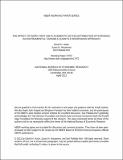The Effect of Work First Job Placements on the Distribution of Earnings: An Instrumental Variable Quantile Regression Approach
Author(s)
Houseman, Susan N.; Autor, David H; Kerr, Sari
Downloadw17972.pdf (495.8Kb)
OPEN_ACCESS_POLICY
Open Access Policy
Creative Commons Attribution-Noncommercial-Share Alike
Terms of use
Metadata
Show full item recordAbstract
Government employment programs for low-skilled workers typically emphasize rapid placement of participants into jobs, of which many are temporary-help jobs. Using data from Detroit’s welfare to-work program and the Chernozhukov-Hansen instrumental variables quantile regression method, we find that neither direct-hire nor temporary-help job placements significantly affect the lower tail of the earnings distribution. In the upper tail, direct-hire placements yield sizable earnings increases for over half of participants, while temporary help placements yield significant earnings losses at higher quantiles. Our results cast doubt on the efficacy of employment programs’ exclusive focus on rapid job placement and their widespread reliance on temporary-help placements.
Date issued
2016-10Department
Massachusetts Institute of Technology. Department of EconomicsJournal
Journal of Labor Economics
Publisher
University of Chicago Press
Citation
Autor, David H. et al. “The Effect of Work First Job Placements on the Distribution of Earnings: An Instrumental Variable Quantile Regression Approach.” Journal of Labor Economics 35, 1 (January 2017): 149–190 © 2016 University of Chicago Press
Version: Original manuscript
ISSN
0734-306X
1537-5307